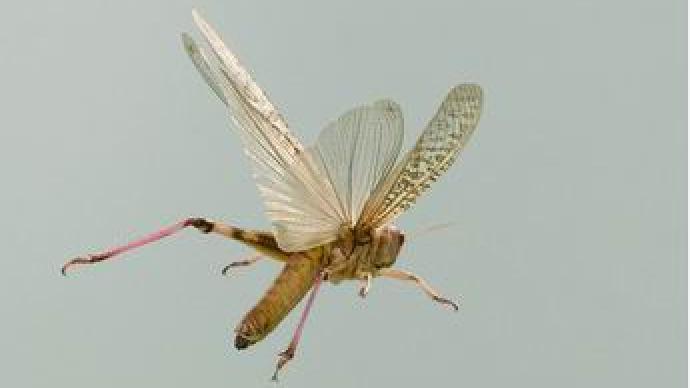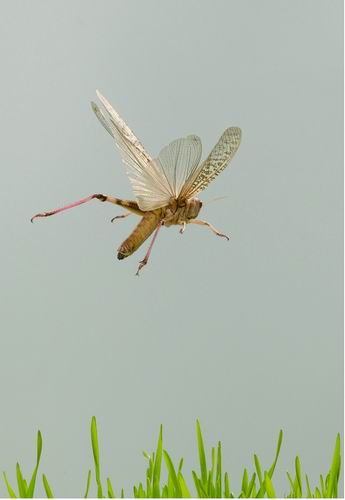

Photo courtesy of the locust interviewee
Oxygen is essential for the life activities of almost all animals. Animals have evolved complex respiratory systems that efficiently deliver oxygen to every part of the body. Still, oxygen shortages occasionally occur when metabolic demand exceeds supply.
Hypoxia-inducible factor (Hif) is considered to be a core protein in organisms that helps cells adapt to hypoxic environments. However, recently, the Kangle team, an academician of the Chinese Academy of Sciences and a researcher at the Institute of Zoology of the Chinese Academy of Sciences, accidentally discovered when studying the flight process of locusts that there is an alternative member of the Hif family. reaction.
The researchers named this particular protein Hif-1α2, which they believe is essential for locusts to achieve long-duration flight. On August 30, the relevant research results were published in eLife and recommended as a highlight article.
Anomaly and confusion
What are the physiological changes and metabolic reactions that occur when oxygen is deficient? For a long time, many scientists have done a lot of research on the molecular switches that sense changes in oxygen in animal cells.
In 1991, it was discovered that a specific DNA-protein complex changes with the change of oxygen concentration, this protein was named "hypoxia-inducible factor".
In 2019, the Nobel Prize in Physiology or Medicine was awarded to two American scientists and one British scientist for their discovery of Hif and its function in regulating adaptation to hypoxia. At the same time, this discovery also provides useful clues and new treatment ideas for the research and treatment of local hypoxia caused by anemia, cancer and many other diseases.
Based on the accumulation of previous studies, it is generally believed that the Hif pathway can be activated only when the organism is in a hypoxic environment, or when tissues and cells are in a hypoxic microenvironment, while under normal oxygen content, the Hif pathway is in a state of inhibition.
Four years ago, Ding Ding, the first author of the paper and a young man in the Kangle team, used molecular biology to study the adaptation of migratory locusts to hypoxia in the high-altitude area of Tibet. Like all scientists who study hypoxia adaptation, Hif is his researcher. Inescapable protein.
The locust is an agricultural pest that can travel hundreds of kilometers every day. During long-distance flights, locusts consume 30 to 150 times more oxygen than at rest. For many insect biology research laboratories, Drosophila is the most basic model insect, but this experimental team is different. They are the only experimental team in the world that uses migratory locusts as model insects.
They let the locusts fly for a while, then removed their flight muscle tissue for protein analysis. In the flight muscle of locusts, two different Hif proteins appeared. So they studied the activity of the two proteins separately at the cellular level. Soon, a strange phenomenon caught Ding Ding's attention: a Hif protein only appeared in the absence of oxygen, while the other Hif protein could exist stably in an aerobic environment. What's more, they also found that the new protein in flight muscles increased dramatically when the locusts flew under normoxic conditions.
"Isn't the Hif pathway activated only in a hypoxic environment?" Ding Ding was a little confused.
He was reminded of another previous study. That result found that the reason why gregarious migratory locusts can migrate long distances is due to their ability to better maintain metabolic homeostasis during flight.
Ding Ding wondered, "Could the new protein be the reason for the maintenance of metabolic homeostasis in locust flight?"
A series of questions piqued his and his research team's interest in digging deeper.
Notched Alternative Protein
When they analyzed two proteins that behaved differently, they found that there was a "gap" in the gene corresponding to the Hif protein, which is stable in normoxia.
Hif protein contains two subunits, α subunit and β subunit, of which the hypoxia sensing subunit is the α subunit, which is called Hif-1α by scientists. Hif-1α has two transactivation domains (TADs), namely N-TAD and C-TAD, C-TAD can play a fine-tuning role, and N-TAD is necessary to activate transcription.
Unlike regular Hif-1α, the newly discovered protein lacks C-TAD. The scientific research team found that it is precisely because of the deletion of this domain that the new protein can maintain a high activity in a normal oxygen environment.
So they named the new protein Hif-1α2 and the original Hif-1α Hif-1α1.
Through a large number of experiments, they also found that Hif-1α2 can directly activate the expression of the target gene DJ-1. The protein encoded by DJ-1 is a key detoxification and antioxidant enzyme in animals, which can effectively remove reactive oxygen species and other harmful metabolites accumulated in the flight muscle of locusts during flight.
"Unlike other insects, migratory locusts can fly for hundreds of kilometers at a time. When migratory locusts fly long distances, they will produce a lot of harmful substances. Hif-1α2 is activated by oxygen to regulate the expression of DJ-1. , can avoid the accumulation of harmful metabolites, so that migratory locusts can adapt to the long-term aerobic metabolic process." said Kang Le, the corresponding author of the paper.
What's more, Hif proteins that are structurally similar to the migratory locust Hif-1α2 type are also present in other animals, especially humans and birds. But until now, the biological function of the Hif protein, which is stable in normoxia, has been unclear.
"The significance of this study is to expand people's understanding of the function of the most central oxygen sensing pathway in the animal kingdom, the Hif pathway. This finding shows that the Hif pathway not only regulates hypoxia response in organisms, but also plays an important role in aerobic physiological processes. It also plays a key role," Kangle said.
"We stand the test of our peers"
With the deepening of the research, the previous puzzles of the research team were solved one by one. They submitted their research paper to eLife, an international biology journal.
According to Kangle, at that time, the journal had an unwritten rule that when submitting a paper for external review, the editor would ask the author if he would like to publish the results of the paper on the preprint platform BioRxiv. Submit the paper for external review.
Kangle told the "Science China Journal" that the paper has a discussion column on the preprint platform, and the content can also be used for editors' reference. Moreover, after the preprint platform is sent out and seen by other peers doing the same research, peers may stop their work. Research. In this way, if the final paper is officially published after external review, the paper can get a higher citation rate, which will also have a positive impact on the journal impact factor.
And for contributors, doing so is risky. "If the manuscript is rejected, it will be very passive." Kang Le said.
However, after receiving an email from the editor asking whether to publish the preprint in advance, Kangle readily agreed: "We can stand the test of our peers."
In the end, all three eLife reviewers agreed for publication. To this end, eLife also invited experts to write review articles for the paper.
Jiwon Shim, a well-known international professor in the same field, pointed out in a special review article that this study revealed a new function of the alternatively spliced Hif.
"Insects are the first animals to be able to fly, perhaps because of the diversity of the Hif gene structure they have produced during long-term evolution, and the emergence of this low-oxygen-independent Hif protein in some species of insects. The diversity of insect flight abilities and ways. This finding also provides important evidence and clues for some biological processes that require the participation of specific Hif proteins, such as animal embryonic development and the formation of certain tumors." Shim said.
Kangle said that in the next step, the research team will study the existence of Hif-1α2 in other organisms horizontally on the one hand, and longitudinally study the production and activity regulation mechanism of this protein on the other hand.
Related paper information:
https://doi.org/10.7554/eLife.74554
https://doi.org/10.7554/eLife.82028
https://doi.org/10.1038/s41467-018-07529-8
(Original title "Alternative Protein Hidden Locust Long Flight Tips")